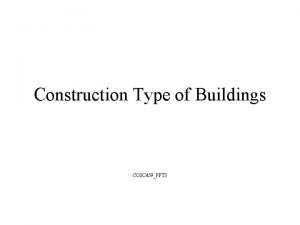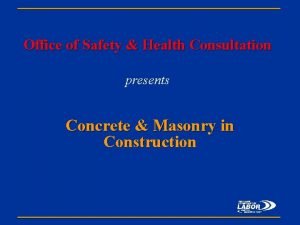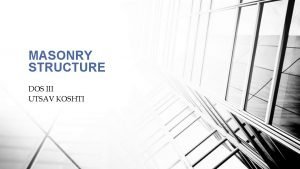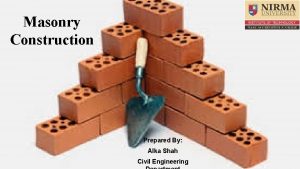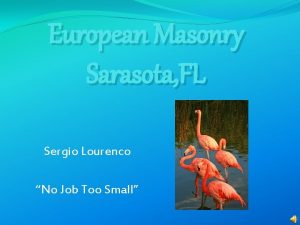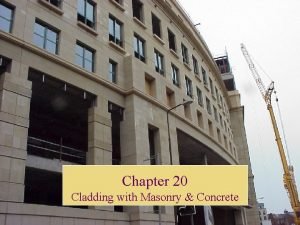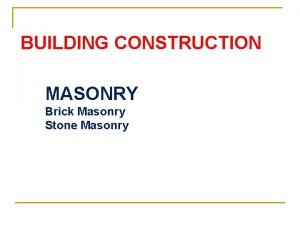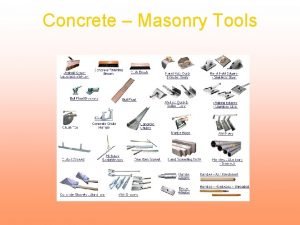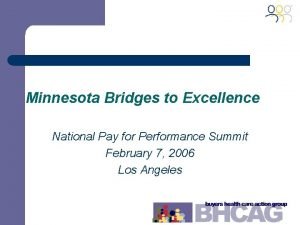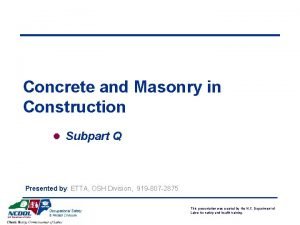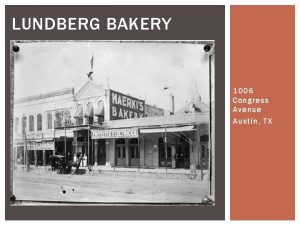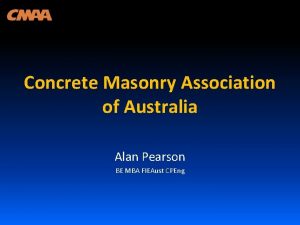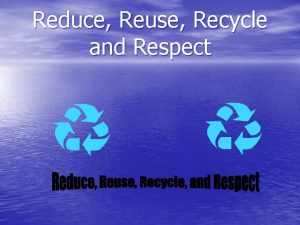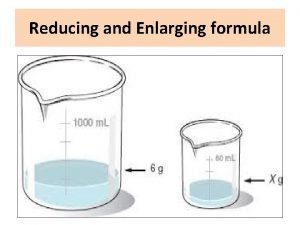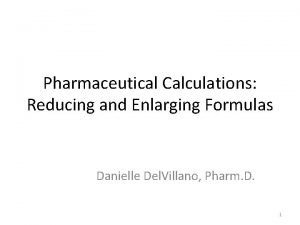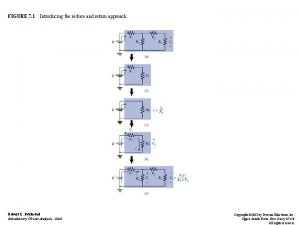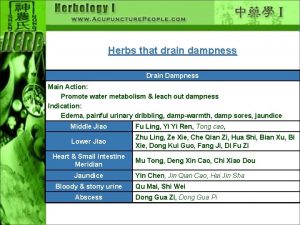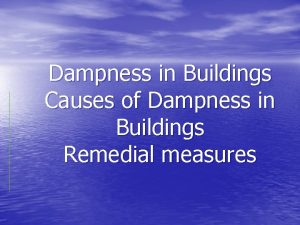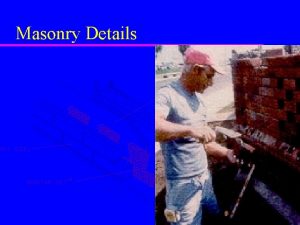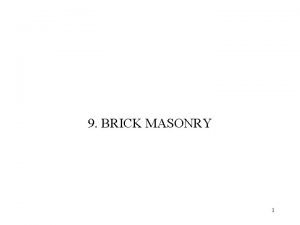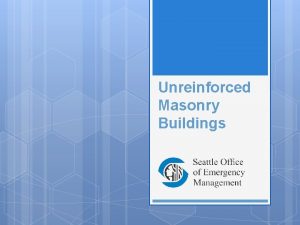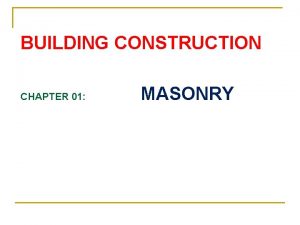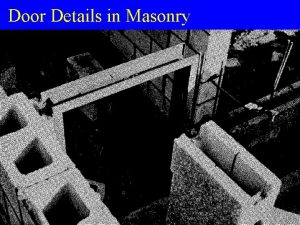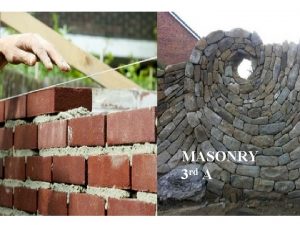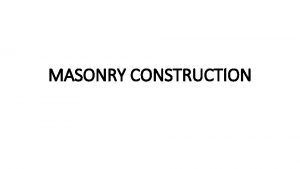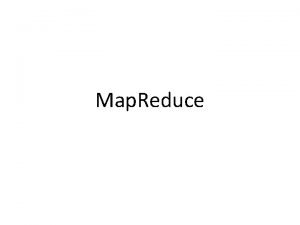Methods to prevent and reduce dampness in masonry

























- Slides: 25

Methods to prevent and reduce dampness in masonry 4 th of june 2018 09 -09 -20 - Pagina 1

Are electrokinetic methods suitable for the treatment of rising damp? Yves Vanhellemont, Michael de Bouw, Samuel Dubois Belgian Building Research Institute (BBRI) Jan Bolhuis, Barbara Lubelli, Linda Miedema, Rob van Hees Delft University of Technology (TUDelft) Yves Vanhellemont yves. vanhellemont@bbri. be 1 09 -09 -20 - Pagina 2

What? ‘electrokinetic dehumidification’ • Sometimes also referred to as ‘electromagnetic’ or ‘electrokybernetic’ dehumidification • ‘pushing back’ rising damp using proper electromagnetic waves • ‘wireless’ form of electroosmosis ? • ‘changing’ the structure of the water molecule ? • ‘influenced by earth rays’ ? Yves Vanhellemont yves. vanhellemont@bbri. be 2 09 -09 -20 - Pagina 3

What? Appearance/characteristics: • Small box, plugged into a normal electricity socket • Action radius, typical 10 meter, around the box • As long as the box is plugged in, the system works. • Necessity of drying? Some suppliers say yes, other disagree Yves Vanhellemont yves. vanhellemont@bbri. be 3 09 -09 -20 - Pagina 4

Advantages • Quick installation • Hardly any damage to historic materials (except for some holes to attach the box to the wall) • Almost fully reversible! Which is not the case with almost all other existing techniques But what can be expected regarding performance? Yves Vanhellemont yves. vanhellemont@bbri. be 4 09 -09 -20 - Pagina 5

Theoretical basis Specific tetrahedral structure of the water molecule (dipole structure) • • • NOT a consequence of interaction between water molecules (as sometimes suggested, in analogy with polarisation between nearby molecules, resulting in so-called Van der Waals forces) This structure causes special physical properties of water, such as high evaporation energy, high surface tension, good solvent for many salts, higher volume for ice, … This structure can not be changed permanently it is only possible to cause vibration around this tetrahedral state, but averaged, this tetrahedral structure remains unchanged. Therefore no possibility to reduce the surface tension of water, and other linked physical properties. Yves Vanhellemont yves. vanhellemont@bbri. be 5 09 -09 -20 - Pagina 6

Capillary structure of stone, animals and plants Euville (14%) Yves Vanhellemont Massangis (14%) Savonnières (32%) brick artificial sand-limestone (32%) yves. vanhellemont@bbri. be (30%) 6 09 -09 -20 - Pagina 7

Capillary structure of stone, animals and plants Blood vessels possible influence by electromagnetic systems…. Remark: fluid transport in plants and animals not (entirely) by capillary forces Yves Vanhellemont yves. vanhellemont@bbri. be 7 09 -09 -20 - Pagina 8

Theoretical basis - conclusions • Influence of an electromagnetic field on the movement of watermolecules (dipoles)? Most probably none. • It is highly improbable to change the properties of a water molecule with electromagnetic waves, and therefore the physical properties of water. It would be more likely that the proper electromagnetic waves would heat up the water, and possibly even desintegrate the water molecules. • If capillary movement could be influences by electromagnetic waves, it could be dangerous to apply this technique in the vicinity of animals, humans or plants. But: the proof of the pudding is in the eating! • Especially because there does not seem to be a concensus about the working principle of such devices. Yves Vanhellemont yves. vanhellemont@bbri. be 8 09 -09 -20 - Pagina 9

Case-studies Method: for a specific building, suffering from rising damp. • Characterisation of the moisture distribution in the wall (in function of depth and height): • Sampling at different heights and depths • Drying of the samples at constant temperature (for instance 60°C) • Weighing of the samples, resulting in the Moisture Content (MC). • Conditioning of the samples in an atmosphere of 95% RH, until equilibrium. • Weighing of the samples resulting in the Hygroscopic Moisture Content (HMC) • Determining the evolution of the moisture distribution, after application of a method against rising damp. • If the moisture content decreases after installation of the device (and in a reference zone without treatment, it does not decrease), and this decrease continues, then one could conclude that the dehumidification is effective. Yves Vanhellemont yves. vanhellemont@bbri. be 9 09 -09 -20 - Pagina 10

Saint Bavo Church, Haarlem (NL) ◘ One of the largest churches in the Netherlands ◘ Built between 1370 and 1520 ◘ Most recent restoration in 1980 -1985 Yves Vanhellemont yves. vanhellemont@bbri. be 10 09 -09 -20 - Pagina 11

Saint Bavo Church, Haarlem (Nl) Yves Vanhellemont yves. vanhellemont@bbri. be 11 09 -09 -20 - Pagina 12

Saint Bavo Church, Haarlem (Nl) • System applied in 2015 in the southern transept • Measurements: • Before application (January 2015) • 12 months after application (January 2016) • Planned: 24 months after application (January 2017) • Measured at 3 locations • Including a reference location outside the area of influence of the device Yves Vanhellemont yves. vanhellemont@bbri. be 12 09 -09 -20 - Pagina 13

Saint Bavo Church, Haarlem (Nl) Yves Vanhellemont yves. vanhellemont@bbri. be 13 09 -09 -20 - Pagina 14

Saint Bavo Church, Haarlem (Nl) • • Results in the reference zone show that there are some fluctuations in MC, which is normal Location 1: • • • Location 2: • Yves Vanhellemont a slight initial decrease in MC at depth 15 -30 cm, but remaining (too) high, even after two years after the installation. At depth 5 -15 cm, hardly any evolution in MC Increase of the MC, for both depths. yves. vanhellemont@bbri. be 14 09 -09 -20 - Pagina 15

Paardenmarkt, Delft (Nl) • • • Yves Vanhellemont Former artillery warehouse Constructed in the 17 th century Constructed in brick masonry, and subject to rising damp and salt crystallisation. yves. vanhellemont@bbri. be 15 09 -09 -20 - Pagina 16

Paardenmarkt, Delft (Nl) • Installation of two systems • Measurements: • Before application • 10 months after application Yves Vanhellemont yves. vanhellemont@bbri. be 16 09 -09 -20 - Pagina 17

Paardenmarkt, Delft (Nl) Yves Vanhellemont yves. vanhellemont@bbri. be 17 09 -09 -20 - Pagina 18

Saint Martin church, Genappe (BE) Yves Vanhellemont • Parish church for the commune of Ways, constructed in 1767 • Listed in 1963 • Structure mainly brick masonry (with a lower part in lime stone), wall thickness about 87 cm • Humidity problems due to proximity of a river, and high groundwaterlevel. yves. vanhellemont@bbri. be 18 09 -09 -20 - Pagina 19

September 9, 2020 20 09 -09 -20 - Pagina 20

Saint Martin church, Genappe (BE) • No significant damage to the walls. • Significant damage to the wooden panels (deformation, moulds, fungi) • Unpleasant moist inner climate Yves Vanhellemont yves. vanhellemont@bbri. be 20 09 -09 -20 - Pagina 21

Saint Martin church, Genappe (BE) Resulting in a very un-even moisture distribution: behind the wall panels, the humidity is much higher than on the outside Wooden wall panels 160 140 87 cm outside Height (cm) inside 120 Humidity behind the wall panels 100 80 60 40 Humidity outside 20 0 0 September 9, 2020 Yves Vanhellemont 2 4 6 8 10 12 Moisture content (weight %) 14 16 22 yves. vanhellemont@bbri. be 21 09 -09 -20 - Pagina 22

Saint Martin church, Genappe (BE) • Product based on siloxanes and aluminiumstearate, dissolved in an organic solvent (zone 1) • Two injection cremes, concentrations between 65 and 80% (zones 2 and 3) • Product based on siloxanes and silanes, emulsion in water (zone 4) • electrokinetic system (zone 5) Yves Vanhellemont yves. vanhellemont@bbri. be 22 09 -09 -20 - Pagina 23

Saint Martin church, Genappe (BE) • Yves Vanhellemont yves. vanhellemont@bbri. be Systematic decrease of MC in all zones, except for zone 5, where MC is even increasing. 23 09 -09 -20 - Pagina 24

Conclusions • Electrokinetic dehumidification systems show lots of potential advantages, of which the reversibility is of great importance for application in heritage buildings. • Its application is evidently only useful if the method is effective. Ø Theoretical arguments indicate at least ‘problems’ with the performance of the method. These arguments are not conclusive, because the working principle behind the method is nog completely clear, and there is disagreement amongst suplliers. Ø If the method would work, then it could be expected to be dangerous for humans, animals and plants. Ø Several test setups have shown that the method is no worthy alternative for other types of interventions against rising damp. Yves Vanhellemont yves. vanhellemont@bbri. be 24 09 -09 -20 - Pagina 25
 Joisted masonry vs masonry non combustible
Joisted masonry vs masonry non combustible Wax pattern in fpd
Wax pattern in fpd According to subpart q
According to subpart q String course in stone masonry
String course in stone masonry Storage bins and silos must be equipped with bottoms
Storage bins and silos must be equipped with bottoms What is masonry
What is masonry Difference between toothing and racking back
Difference between toothing and racking back Masonry sarasota fl
Masonry sarasota fl Articulated masonry veneer
Articulated masonry veneer Corbel in stone masonry
Corbel in stone masonry Raking bond in brick masonry
Raking bond in brick masonry Common float in masonry
Common float in masonry Double flemish bond in brick masonry
Double flemish bond in brick masonry As 4773 masonry in small buildings
As 4773 masonry in small buildings Barry cargill masonry
Barry cargill masonry Lift slab operations must be designed and planned by
Lift slab operations must be designed and planned by Handles on these must not extend beyond
Handles on these must not extend beyond Dry masonry
Dry masonry Lundberg masonry
Lundberg masonry Cmaa masonry
Cmaa masonry A gravity dam of trapezoidal cross section
A gravity dam of trapezoidal cross section Reduce reuse recycle and respect
Reduce reuse recycle and respect Defensive driving facts
Defensive driving facts Factor method in reducing and enlarging formula
Factor method in reducing and enlarging formula Reducing and enlarging
Reducing and enlarging Boylestad
Boylestad
